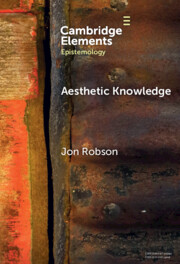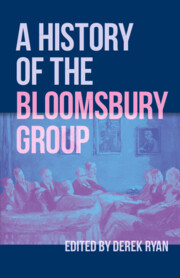Refine search
Actions for selected content:
361 results
Chapter 1 - The Utopian Impulse in British Literature and Culture since 1945
-
-
- Book:
- The Cambridge Companion to British Utopian Literature and Culture since 1945
- Published online:
- 18 December 2025
- Print publication:
- 31 January 2026, pp 1-34
-
- Chapter
- Export citation
2 - Forma and materia
- from Part I - The Concepts
-
- Book:
- The State in Machiavelli
- Published online:
- 29 December 2025
- Print publication:
- 31 January 2026, pp 71-112
-
- Chapter
- Export citation
Chapter 13 - Aesthetics and Philosophy
- from Part III - Cultural and Intellectual Worlds
-
-
- Book:
- Fanny Hensel and Felix Mendelssohn in Context
- Published online:
- 19 December 2025
- Print publication:
- 08 January 2026, pp 101-108
-
- Chapter
- Export citation

Aesthetic Knowledge
-
- Published online:
- 11 November 2025
- Print publication:
- 04 December 2025
-
- Element
- Export citation
Chapter 16 - ‘Usefully Unofficial’ Reading
- from Part III - New Genres
-
-
- Book:
- African Literature in Transition
- Published online:
- 23 October 2025
- Print publication:
- 06 November 2025, pp 313-332
-
- Chapter
- Export citation
Chapter 6 - Bloomsbury and Music
- from Part I - Aesthetic Bloomsbury
-
-
- Book:
- A History of the Bloomsbury Group
- Published online:
- 09 October 2025
- Print publication:
- 23 October 2025, pp 86-101
-
- Chapter
- Export citation
4 - Haydn’s Last Heroine: Hanne, The Seasons, and the Culture of Sensibility
-
-
- Book:
- Haydn Studies 2
- Published online:
- 18 October 2025
- Print publication:
- 16 October 2025, pp 70-100
-
- Chapter
- Export citation

A History of the Bloomsbury Group
-
- Published online:
- 09 October 2025
- Print publication:
- 23 October 2025
13 - Liturgy, Icons, and Images
- from Part III - Liturgy and the Arts
-
-
- Book:
- The Cambridge Companion to Christian Liturgy
- Published online:
- 19 September 2025
- Print publication:
- 09 October 2025, pp 232-248
-
- Chapter
- Export citation
2 - A Modern Empress
-
- Book:
- Türkiye, Iran, and the Politics of Comparison
- Published online:
- 21 September 2025
- Print publication:
- 09 October 2025, pp 75-114
-
- Chapter
- Export citation

Manufacturing Dissent
- American Modernism and the Science of Belief
-
- Published online:
- 03 October 2025
- Print publication:
- 21 August 2025
The influence of aesthetic taste on product choice: does mode of evaluation impact decision making?
-
- Journal:
- Proceedings of the Design Society / Volume 5 / August 2025
- Published online by Cambridge University Press:
- 27 August 2025, pp. 3051-3060
-
- Article
-
- You have access
- Open access
- HTML
- Export citation
2 - Stephen Hero and A Portrait of the Artist as a Young Man
-
-
- Book:
- The Cambridge Companion to James Joyce
- Published online:
- 14 August 2025
- Print publication:
- 21 August 2025, pp 31-46
-
- Chapter
- Export citation
Chapter 3 - World War Gothic
-
- Book:
- Manufacturing Dissent
- Published online:
- 03 October 2025
- Print publication:
- 21 August 2025, pp 87-122
-
- Chapter
- Export citation
Introduction
-
- Book:
- Manufacturing Dissent
- Published online:
- 03 October 2025
- Print publication:
- 21 August 2025, pp 1-15
-
- Chapter
- Export citation
6 - The Literary Singularity of Roots Manuva’s Awfully Deep
- from Part II - Approaches to Rap
-
-
- Book:
- The Cambridge Companion to Global Rap
- Published online:
- 25 July 2025
- Print publication:
- 14 August 2025, pp 100-112
-
- Chapter
- Export citation
5 - Pioneers, Postmodernisms and Aesthetic Experience
- from Part II - Approaches to Rap
-
-
- Book:
- The Cambridge Companion to Global Rap
- Published online:
- 25 July 2025
- Print publication:
- 14 August 2025, pp 88-99
-
- Chapter
- Export citation

Zola's Dream
- Idealism on Trial
-
- Published online:
- 07 August 2025
- Print publication:
- 21 August 2025
Deleuze and the ontology of prehistoric rock art
-
- Journal:
- Archaeological Dialogues , First View
- Published online by Cambridge University Press:
- 01 August 2025, pp. 1-20
-
- Article
-
- You have access
- Open access
- HTML
- Export citation
Chapter 10 - Epilogue: Ethics, Aesthetics, and Poiesis
-
- Book:
- Healing and the Invention of Metaphor
- Published online:
- 17 July 2025
- Print publication:
- 31 July 2025, pp 261-283
-
- Chapter
- Export citation
